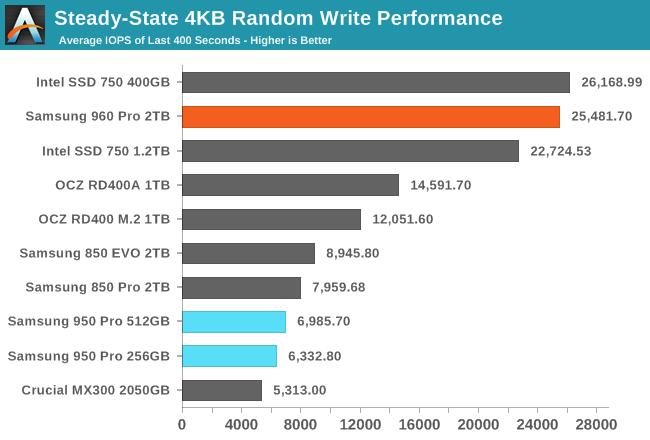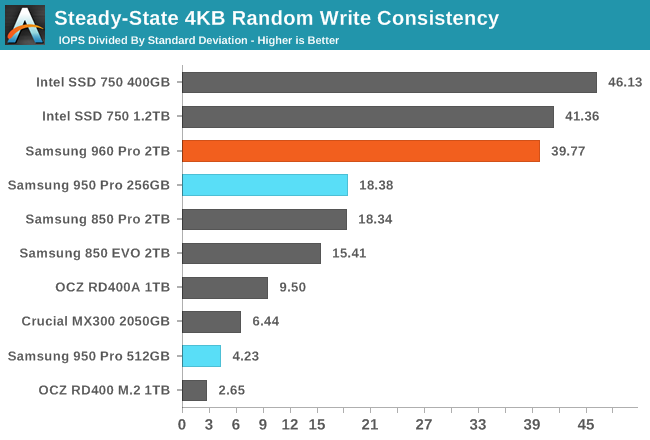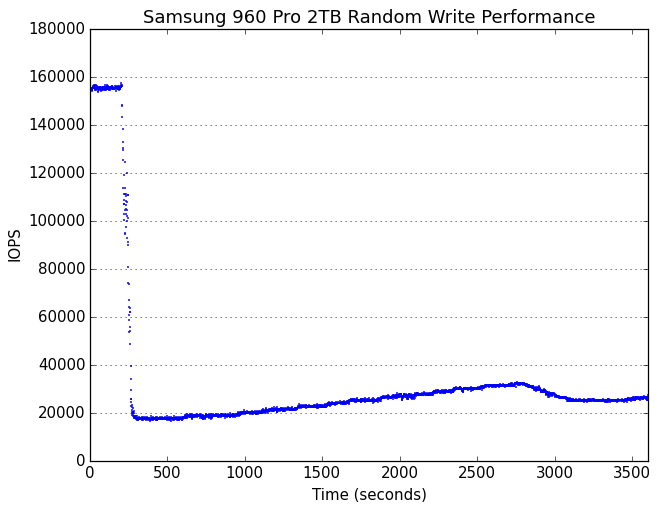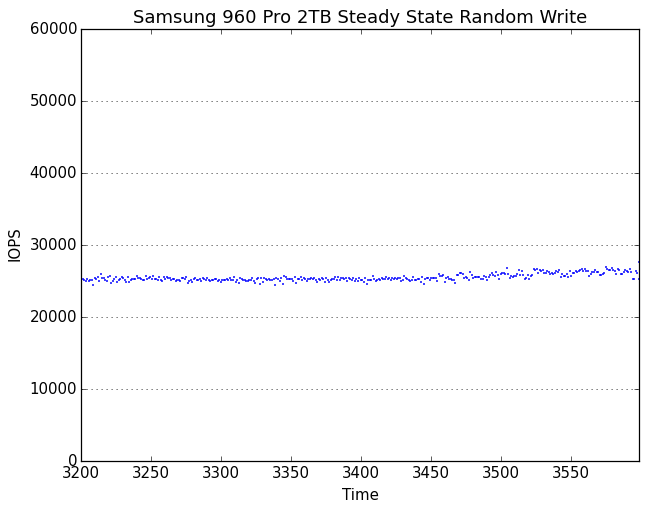The Samsung 960 Pro (2TB) SSD Review
by Billy Tallis on October 18, 2016 10:00 AM ESTPerformance Consistency
Our performance consistency test explores the extent to which a drive can reliably sustain performance during a long-duration random write test. Specifications for consumer drives typically list peak performance numbers only attainable in ideal conditions. The performance in a worst-case scenario can be drastically different as over the course of a long test drives can run out of spare area, have to start performing garbage collection, and sometimes even reach power or thermal limits.
In addition to an overall decline in performance, a long test can show patterns in how performance varies on shorter timescales. Some drives will exhibit very little variance in performance from second to second, while others will show massive drops in performance during each garbage collection cycle but otherwise maintain good performance, and others show constantly wide variance. If a drive periodically slows to hard drive levels of performance, it may feel slow to use even if its overall average performance is very high.
To maximally stress the drive's controller and force it to perform garbage collection and wear leveling, this test conducts 4kB random writes with a queue depth of 32. The drive is filled before the start of the test, and the test duration is one hour. Any spare area will be exhausted early in the test and by the end of the hour even the largest drives with the most overprovisioning will have reached a steady state. We use the last 400 seconds of the test to score the drive both on steady-state average writes per second and on its performance divided by the standard deviation.

The enterprise SSD heritage of the Intel SSD 750 continues to shine through as it holds on to the lead for steady-state random write performance, but Samsung has mostly caught up with the 960 Pro. This is a huge change from the 950 Pro, which had steady-state performance that was no better than typical SATA SSDs. A few consumer SSDs have offered great steady-state random write performance—most notably OCZ's drives based on the Indilinx Barefoot 3 controller—but the 960 Pro is the first one to reach the level of the Intel SSD 750.

In addition to mostly closing the performance gap, the 960 Pro has a great consistency score that is almost as good as the Intel SSD 750's score. While OCZ's Vector 180 offered remarkably high average performance in its steady state, it was far less consistent than the either the Samsung 960 Pro or the Intel SSD 750 and instead the standard deviation of its steady state performance was more than ten times greater.
 |
|||||||||
| Default | |||||||||
| 25% Over-Provisioning | |||||||||
After the initial period of very high performance, the 960 Pro enters a steady state with very good short-term consistency but gradual long-term variation in performance. This is more similar in character to the behavior of the Intel SSD 750 than Samsung's earlier SSDs, though it's interesting to note that the 960 Pro is more twice as fast during the initial phase before transitioning to steady state.
 |
|||||||||
| Default | |||||||||
| 25% Over-Provisioning | |||||||||
Focusing on the last 400 seconds of the test shows the 960 Pro's steady state to be essentially flawless, rounding out a full page of what can be considered to be perfect scores for a consumer drive. The performance would even make the 960 Pro a pretty good enterprise SSD, and this is usually not the case for drives with consumer-oriented firmware.










72 Comments
View All Comments
Billy Tallis - Tuesday, October 18, 2016 - link
The Intel 600p is very high on my to-do list. Since it's also using the Microsoft NVMe driver I want to run it through some more tests before publishing the review, but it should be done before I get the 960 EVO.WatcherCK - Tuesday, October 18, 2016 - link
Curious about the operating temperatures of the drive, Im guessing that Destroyer gave it a good thermal workout :) Puget Systems have done some testing on the effect of adding cooling to M2 SSDs:https://www.pugetsystems.com/labs/articles/Samsung...
Aquacomputer also make a PCIe Riser card equipped waterblock for M2 drives for those who want to water cool their SSD, the kryoM.2
Does anyone know if moving an M2 drive to a riser card improves cooling for the drive? I would think there is a little bit of improvement bringing the drive off the surface of the motherboard... How if at all is everyone keeping their motherboard mounted SSDs cool?
BurntMyBacon - Wednesday, October 19, 2016 - link
@WatcherCKYes, moving an M.2 drive to a riser card improves cooling (at least in my system). I checked temperatures mounted on my motherboard with a spot cooler directly on the 950Pro. I then compared it against mounting on a Silverstone ECM20 and an Asus Hyper M.2 X4 Mini (no spot cooler). If you are able to direct good airflow to the riser card, as I was, the Asus riser card is significantly cooler even though it had no spot cooler. If you use a thermal pad on the back of the M.2 drive on the Silverstone EMC20, it may in fact do even better than the Asus, but it my system, the larger standoffs allowed more air to flow behind the M.2 drive on the Asus solution. In any case, I can't seem to induce thermal throttling on my 950Pro in my setup regardless of how hard I try. Again, it will depend on how much airflow you can deliver it.
Gradius2 - Tuesday, October 18, 2016 - link
Those SSDs suffering from HEAT. If you don't put a forced cooling on them, it will DEGRADE the speed no matter what! This is why you won't see much than 3GB/s !iwod - Wednesday, October 19, 2016 - link
Where are these performance heading. Where Do we need to go. The destroyers and heavy definitely dont represent 95% of the consumer users usage. Do we need more higher Random Q1 Read Write? Or do we need higher Seq Read Write? If so then we dont need our firmware and powerful CPU core for QD32. Will that save cost? Why are we still within the 5W power usage? When can we get those dropped down to 2W or less.zodiacfml - Wednesday, October 19, 2016 - link
blazing fast. i will not be able to make useod this speed except for W10 upgradesprofdre - Monday, October 24, 2016 - link
@ Billy Talis: Would it be possible to test on another mainboard? There seems to be a clear bandwidth issue for sequential transfers, as other tech sites as https://www.computerbase.de/2016-10/samsung-ssd-96... achieved almost 3400 MB/s in CrystalDiskMark for the 512 GB model. At first they struggled to reach more than 3100 MB/s. (Samsung values were achieved with CrystalDiskMark according to computerbase).calbear88 - Tuesday, November 15, 2016 - link
Great table in the article summarizing the different Samsung NAND technologies. Here's a summary of the different types of NAND and which products they were in.27nm MLC 830 PM830
21nm MLC 840 pro
21nm TLC 840
19nm MLC XP941
19nm TLC 840 Evo
16nm MLC SM951
16nm TLC 750 Evo PM951
32 layer 86bit v-NAND MLC 850 Pro
32 layer 128bit v-NAND TLC 850 Evo
32 layer 128bit v-NAND MLC 950 Pro
48 layer 128bit v-NAND MLC 960 Pro SM961
48 layer 128bit v-NAND TLC 960 Evo PM961
Meteor2 - Wednesday, November 23, 2016 - link
How is new dies and an entirely new controller 'just a generational refresh of the 950 Pro', from any angle?anaconda1 - Monday, February 13, 2017 - link
The Samsung 2.1 driver has DPC latency issues on my end. I am usign a Samsung 960 500GB Evo nvme and using it with the Native Microsoft Driver (Windows 10 with latest updates installed) or the Samsung 2.0 driver, all is ok, DPC latency reports are fine - Latencymon and latency checker both report trouble free operation. However, installing the 2.1 driver, both Latencymon and dpc latency checker report problems with storport.sys and problems with DPC. Rolling back the driver from the Samsung 2.1 to the Microsoft or the Samsung 2.0, all goes back to normal